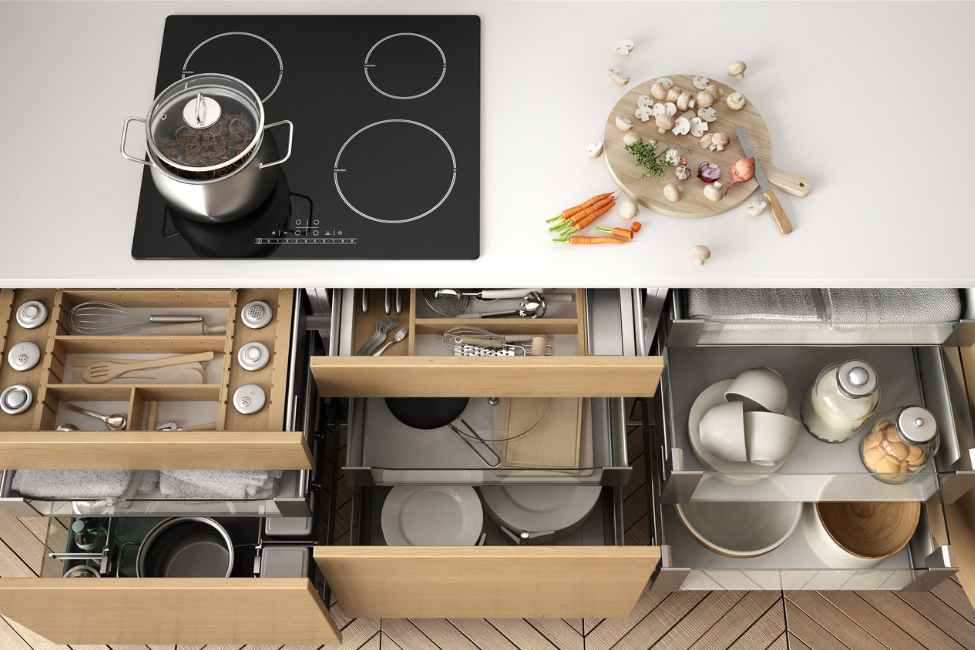Organizing a kitchen can seem like a daunting task, especially when you don’t know where to start. But it doesn’t have to be hard! With the right tips and tricks, you can easily create an organized, efficient kitchen. Whether you’re new to organizing or just need a refresher, this article will give you the guidance and resources you need to get your kitchen in tip-top shape.
You’ll learn how to manage your pantry items, organize your utensils, and declutter countertops. By implementing these strategies in a few simple steps, you’ll have an organized kitchen that makes meal prep faster and easier than ever before.
Don’t wait any longer – let’s get started on organizing your kitchen! You’ll be amazed at what a difference it makes in the overall look and efficiency of your space.
Ready to take on the challenge? Let’s do this!

Assess Your Needs
Assessing your needs is the first step in organizing your kitchen. Take some time to look around the room and make a list of anything you don’t use or need. This will help you decide what items to keep and what should be thrown away or donated.
Next, think about how you want to arrange the items in your kitchen. Consider how often you use them, and if there are any items that would be more convenient if they were closer at hand while cooking or baking. You may also want to consider organizing items by category, such as cookware, dishes, food storage containers, etc., so that everything is easier to find and access when needed.
Once you have an idea of how you’d like things laid out, it’s time to start putting it all into action. Clear out any clutter that isn’t necessary and start arranging items according to your plan. As you go along, evaluate which containers work best for each type of item – this can help save space and ensure everything has its place in your newly organized kitchen.
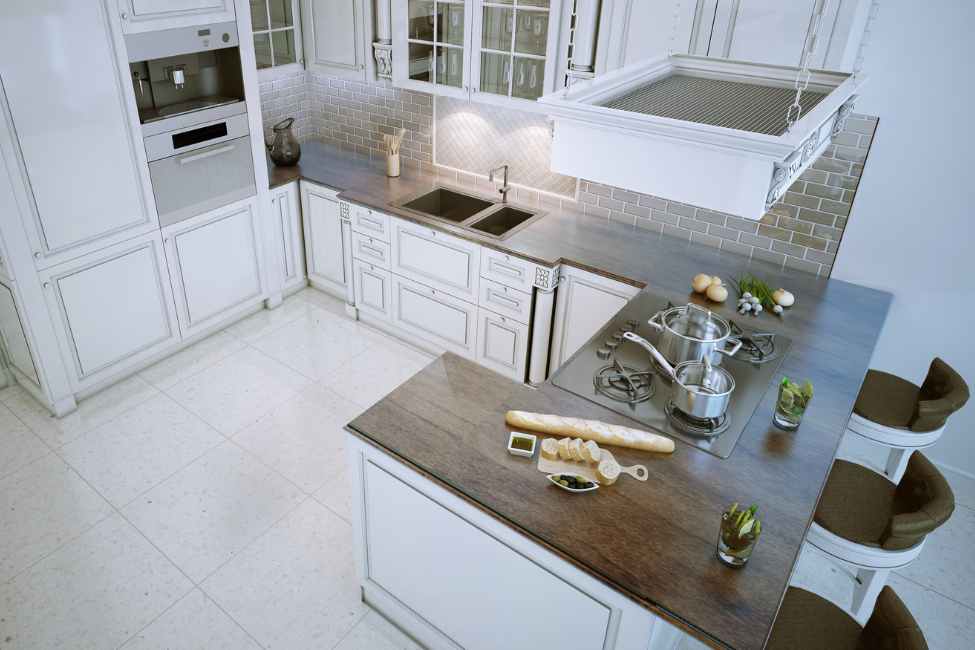
Choose A Layout
The layout of your kitchen is an important factor in organizing it. It’s essential to determine what works best for you and your space, whether that be a one-wall kitchen or an L-shaped kitchen. When deciding on a layout, think about how you’re going to use the space. Consider where appliances will go, such as the refrigerator and range, and make sure there’s enough counter space for food preparation.
Make sure to also consider storage possibilities when coming up with a plan. Think about where you can store items like cooking supplies, baking pans, and dishes. Creating designated spaces for these items in advance can help ensure everything stays organized. Installing cabinets or shelves can provide much needed storage space while also adding visual appeal to the room.
When picking out furniture or appliances for your kitchen, it’s important to measure the area first so that everything fits properly. Additionally, don’t forget to leave some extra room around each item so that you can move freely without feeling cramped or crowded in the space. Once all elements are figured out and placed accordingly, you’ll have a well-designed kitchen that is both organized and aesthetically pleasing.

Clear The Clutter
Now that you have a plan for the layout of your kitchen, it’s time to clear out the clutter. Going through all of your items can be a daunting task, but it doesn’t have to be! Here are some tips to help you get started:
First, go through each room one at a time and remove any items that don’t belong there. This could include items that are broken or worn out and should be thrown away. Also, if you haven’t used something in the past year, consider donating or selling it. Keeping only the essentials will help create more space in the kitchen.
Next, start organizing the items that remain in your kitchen. Group like items together so they are easy to find when you need them. For example, store all baking supplies in one cabinet, or put all pots and pans together. You can also use dividers, baskets or drawer organizers to keep everything neat and organized.
Finally, take some time to regularly maintain your kitchen organization system by decluttering regularly and making sure everything has its place. Setting aside even just 15 minutes once a week can make a big difference in helping keep things tidy and orderly!
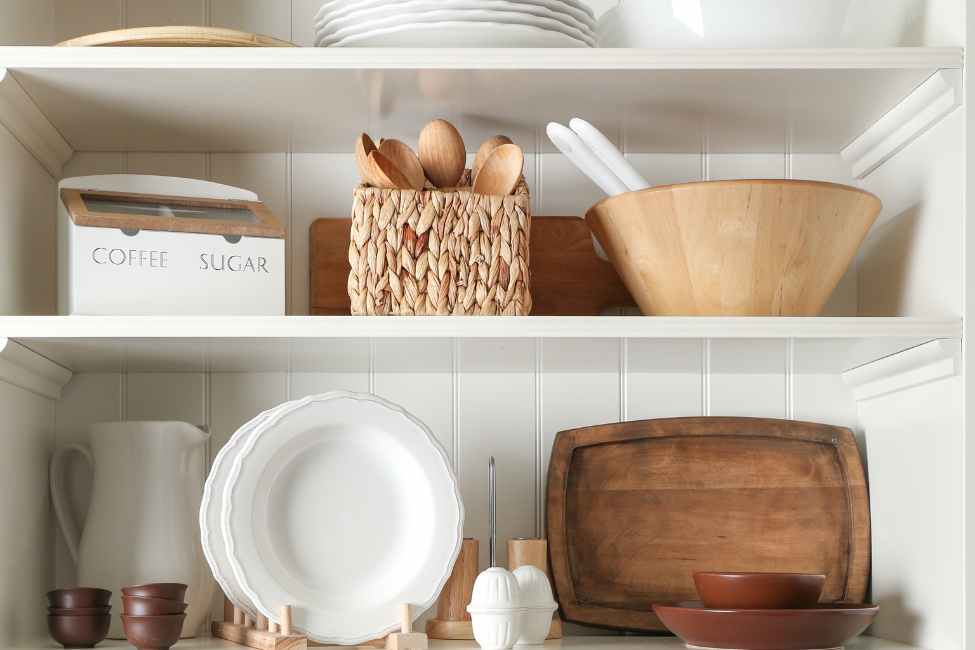
Store Necessities
Storing your kitchen necessities is essential for an organized kitchen. The process begins with decluttering and removing unnecessary items. This will help to make the organizing process easier and more effective. Once you have cleared out the clutter, it’s time to start storing items in a way that makes sense.
The most important part of storing your kitchen necessities is to find a place for everything so it can be easily accessed when needed. You should create dedicated areas for each type of item such as pots and pans, dishes, utensils, spices, etc. For example, you can use shelves or cabinets for dishes and utensils while drawers can be used for smaller items like spices or baking supplies. You should also consider using hooks on the wall to hang up frequently used items such as pots and pans.
You’ll also want to label all of your containers so that you know exactly what is inside at a glance. This will save you time and help keep things neat and organized. Additionally, using clear storage containers will allow you to quickly identify what is stored inside without having to open them up each time. Taking these steps will ensure that your kitchen remains organized and easy to navigate.
Making sure that everything has its own place in the kitchen is key for keeping it organized and efficient. By taking some time to think about how you should store your items, you’ll be able to create a space where everything has its place and is easily accessible when needed.
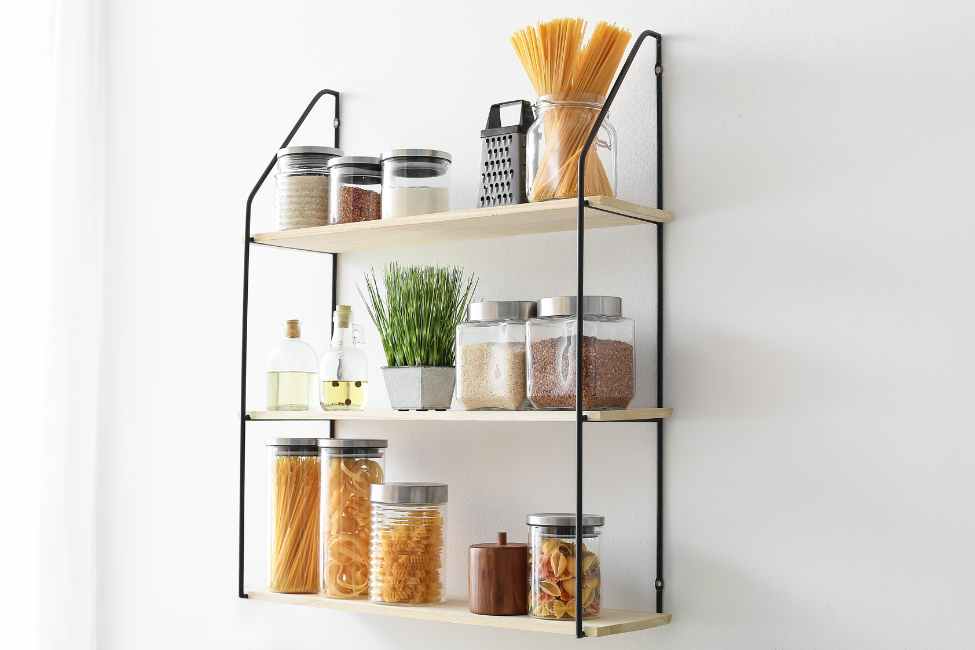
Utilize Vertical Space
Utilizing vertical space can be one of the most effective ways to organize your kitchen. By doing this, you can maximize the storage capacity even in a smaller kitchen. For example, you can use wall-mounted shelves and racks to store often used items like spices and condiments. You could also hang a pot rack from the ceiling for easy access pots and pans. If you have some extra counter space, you could install a pull-out shelf or drawer near your sink to store items like dish soap and sponges.
Another way to make use of vertical space is to use pegboards or magnetic strips on walls or sides of cabinets. This will allow you to store items like knives, scissors, measuring cups, and other utensils in an organized manner while being easily accessible when needed. Finally, consider using overhead cabinets with sliding doors that are out of reach but still within view so that you can easily identify what’s stored inside without having to open them every time.
Organizing your kitchen with these tips will help save time and energy when cooking meals since all the necessary ingredients and tools will be readily available. With a few simple changes, it’ll be easier than ever before to keep your kitchen neat and tidy!
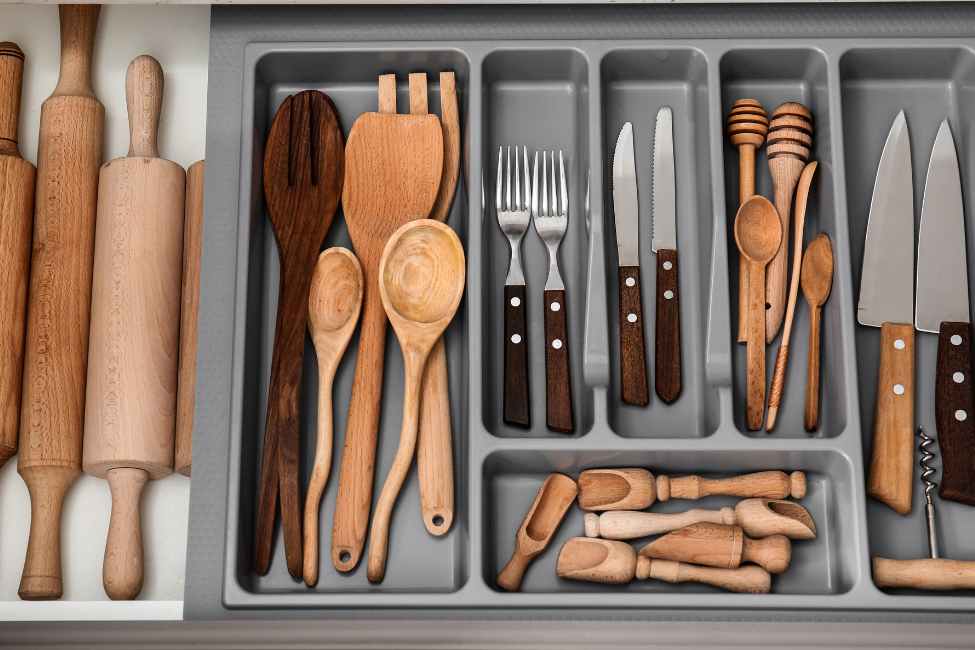
Group Similar Items Together
When organizing your kitchen, it’s important to group similar items together. This will help you find what you need quickly and easily. To do this, start by evaluating what kind of kitchen items you have. For example, separate out all the utensils, such as forks, spoons, knives and other kitchen tools. Additionally, separate out any baking items like measuring cups and spoons, mixing bowls and cake pans.
Next, decide where you want to store each item. Utensils can be stored in drawers or bins that are easily accessible and organized according to size and type of utensil. Baking items can be stored in a cabinet away from heat sources so they don’t warp or melt when exposed to high temperatures. Finally, organize cookware within easy reach of the stovetop or oven so that it’s convenient for cooking meals.
Organizing your kitchen will make meal preparation easier by giving you quick access to the items you need. Keep similar items together for even more convenience when cooking or baking in your kitchen!
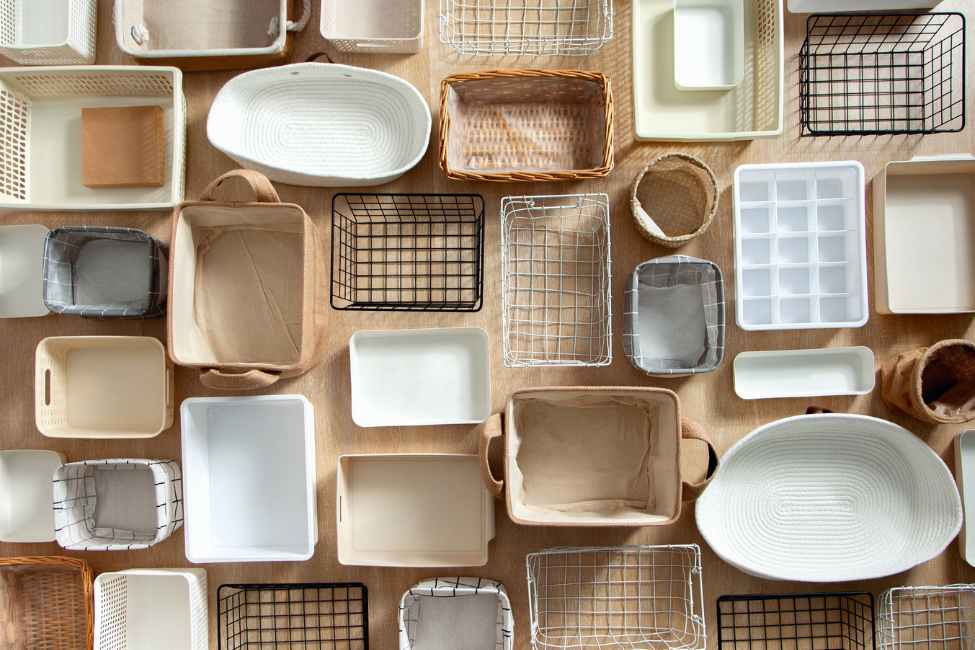
Utilize Containers And Baskets
Utilizing containers and baskets to organize your kitchen is key. It’s a great way to make sure everything has its place and is easily accessible. You can use them for anything from pantry items, to small appliances, to utensils, and more. They come in a variety of sizes and materials, so you can pick the one that best fits your needs. Plus, they’re stylish and make it easier to keep your kitchen looking tidy.
When storing items in containers or baskets, try to group like-items together so that you know where things are when you need them. It’s also helpful if you label each container so that you don’t have to search through all of them when looking for something specific. Additionally, if space allows it, consider installing shelves or drawers in your kitchen cupboards for extra storage options. This will help even more with keeping everything organized and easy to find.
For larger items like pots and pans that don’t fit into containers or baskets well, there are other options such as pot racks or peg boards which can be hung up on walls for easy access. These solutions help keep the clutter off of countertops while still allowing you to get whatever you need quickly without having to rummage around your cabinets every time you’re cooking something new.
Organizing your kitchen can seem daunting at first but with some thoughtfulness and planning plus the right storage solutions, it doesn’t have to be difficult at all! The key is finding the most efficient ways possible for keeping things neat and tidy while still being able to access what you need quickly when needed.

Label Everything
Now that you’ve organized your kitchen with containers and baskets, it’s time to label everything. Labeling items helps you quickly identify what goes where, so it’s important to take the time to do this step.
First, decide how you want to label each item. You can use labels or stickers, write directly on the container or basket itself, or use something like chalkboard paint for a more creative approach.
Next, make sure the labels are clear and easy to read. You’ll want something legible enough that you don’t have to strain your eyes when trying to find something in the kitchen. Consider using a labeling machine if you have a lot of items that need labeling, as this will save time while ensuring all your labels are neat and uniform.
Organizing your kitchen efficiently is key for keeping it tidy and clutter-free. Taking the extra step of labeling everything will help ensure that it stays organized and makes finding things much easier.
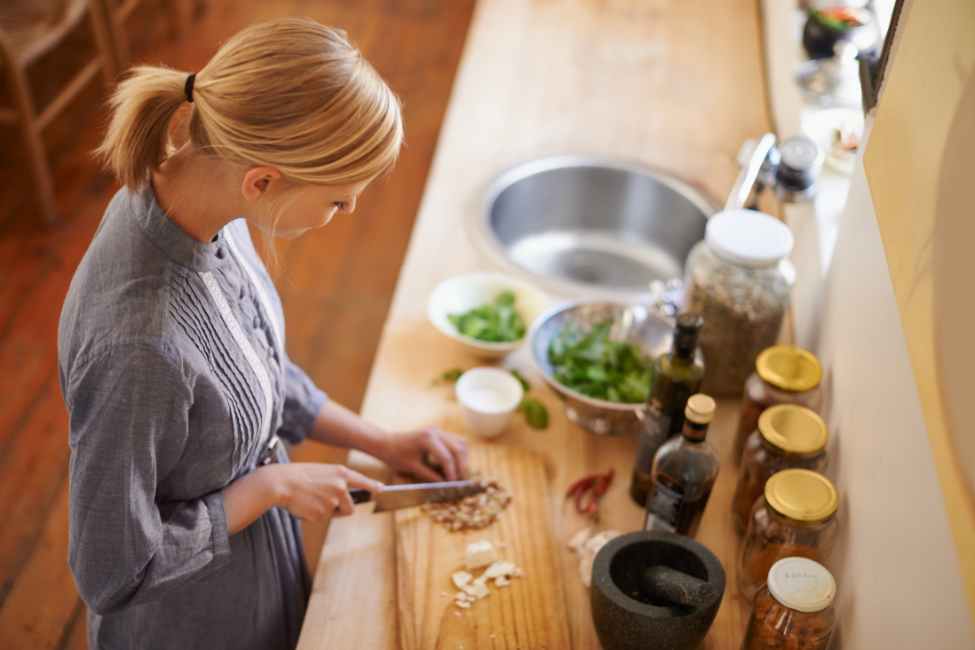
Create A Meal Prep Station
Creating a meal prep station is an excellent way to get organized in the kitchen. This will help make cooking easier, faster, and more efficient. The first step is to designate a specific area of your kitchen for prepping meals. Make sure you have plenty of counter space available and that the area is easily accessible.
Next, gather all the necessary tools and supplies that you need for meal prep such as cutting boards, knives, measuring cups and spoons, mixing bowls, food storage containers, and so on. If there’s not enough space on your counters for all these items, consider using a cart or shelf nearby to store them.
Finally, organize your ingredients by type so you know exactly where everything is located when it’s time to cook. Consider storing frequently used items like spices at eye-level for easy access. By setting up a special meal prep station in your kitchen, you can save yourself time and energy during the cooking process.

Make Cleaning Easier
Now that you have your meal prep station set up, it’s time to make cleaning easier. A key part of organizing a kitchen is making sure it is clean and tidy. This will help you maintain an organized kitchen in the long run.
Start by decluttering your countertops and any other surfaces. Remove any items that are not used regularly or items that do not belong in the kitchen. This will help open up space for other items that you use often. You can also buy containers or baskets to store certain items like utensils, spices, and condiments. This will keep everything neat and easily accessible when needed.
You should also create a routine for cleaning the kitchen on a weekly basis, such as wiping down the counters, washing dishes, sweeping the floor, etc. Scheduling regular deep cleanings throughout the year is also important to ensure your kitchen stays in good condition. Taking these steps will make cleaning much simpler so you can enjoy a clutter-free space every day.
First, get creative with food storage. Invest in containers and baskets specifically designed for food storage so you can take advantage of any available vertical space. Make sure to label each container so it’s easy to find items when you need them.
Second, think about ways to keep your kitchen clean on a daily basis. Clean as you go to avoid clutter build-up and deep cleaning sessions later on. Designate certain areas or shelves for specific items, and make sure they’re returned back to their place after each use. This will help ensure that your kitchen is always neat and tidy.
Finally, don’t forget the importance of creative organization ideas. Find unique ways to store items such as repurposing mason jars or using hanging pots and pans rack if the space allows it. By taking the time to make sure your kitchen is organized, you’ll save yourself time and energy in the long run!

